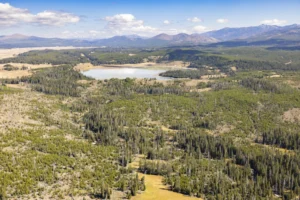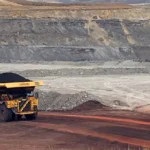Gold Mine West of Cheyenne State’s First in a Century
Proposed project could bring around 200 jobs to Laramie County
- Published In: Other News & Features
- Last Updated: Jul 19, 2023

The CK Gold Project is located at the site of the historic Copper King Mine in Wyoming’s Silver Crown Mining District. Seen here is a historic mine entrance. (Courtesy photo from the U.S. Gold Corp.)
By Carrie Haderlie
Special to the Wyoming Truth
Plans for a gold mine in southeastern Wyoming are well underway, although similar activity ceased a century ago.
“There hasn’t been a copper and gold mine in Wyoming for many years,” George Bee, President and CEO of U.S. Gold, said in an interview with the Wyoming Truth.
Once operational, the mine will employ around 200 people.
The CK Gold Project site sits 20 miles west of Cheyenne on two-and-a-half square miles of private and state-owned land. In April, the State Board of Land Commissioners set a royalty rate of 2.1% on metallic and non-metallic rocks and minerals mined at two leased parcels of state trust land for U.S. Gold Corp. On June 20, the Wyoming Department of Environmental Quality granted an industrial siting permit to U.S. Gold for construction and operation of the proposed mine.
The CK Gold Project is at the historic Copper King Mine site in Wyoming’s Silver Crown Mining District.
“The clue in the late 1800s when the railways came through was green staining on the rocks and outcroppings,” Bee said. “When copper oxidizes, it turns green. A lot of folks engaged in the railroad had been prospectors, so that was why the Silver Crown Mining District came to be.”
In those days, mining was done through underground tunnels and mine shafts, with miners searching for high-grade deposits, Bee said. When those were mined out, activity waned.
“Fast forward to now, or the last few decades, and we know that there is copper and gold there,” Bee said. “Now, with big, earth-moving equipment … we can move very large quantities of rock, and we can go after lower-grade copper and gold.”

The industrial siting permit is one of two critical permits necessary for construction and operation of the proposed mine. U.S. Gold expects the second permit, a mine operating permit and mine closure plan, to be approved in 2024.
Randall Luthi, Gov. Mark Gordon’s chief energy advisor, said Gordon supports projects in Wyoming that “will provide local jobs and revenue for the local community and state, provided those projects meet strict environmental standards.”
“The proposed CK Gold Mine proposal is identifying potential impacts and benefits, which includes the opportunity for public comment through the Department of Environmental Quality permitting process,” Luthi said in an email to the Wyoming Truth. “Certainly, the mine would be a great boost to the economy of Laramie County.”
Once operational, the mine will resemble a quarry, Bee said.
“We don’t have to go underground with our picks and shovels, digging into high-grade veins. There wouldn’t be enough of it to do that way,” Bee said. “We are now targeting what is called a porphyry deposit. The porphyry deposit has disseminated copper and disseminated gold in this hard, granite diorite type of rock.”
Economic booster
While the mine has potential to yield both copper and gold, the gold “is by far the revenue producer,” according to geologist Dave Hammond with Stagg Resource Consultants, Inc.
“I would consider the copper just a byproduct,” Hammond, who also spoke before the Office of State Lands during the mineral royalty rate hearing in April, said. “The gold provides the revenue. The copper dictates the process, so the process they will use is what you would use in a copper mine.”
Hammond said the mine could produce about 12,000 to 13,000 tons of cathode copper per year, while a mid-sized mine might produce 300,000 tons of copper a year.
Crews at the open-pit mine will process 20,000 tons of ore per day, which will be extracted through blasting and excavation. Ore will be hauled to an on-site mill for crushing and flotation, with an end-product of a gold/copper concentrate that will be sent out of Wyoming for refining.
Twenty percent of every ton sent to a smelter will be copper. Bee also anticipates recovering around two to three ounces of gold per ton.
“This deposit is very clean. It doesn’t have mercury in it, it doesn’t have any arsenic in it. It will be a high-value concentrate,” Bee said.
The project has an 18-month construction period and an anticipated lifespan of 10 years. Reclamation plans include a vegetated area where spent material will go.
“To get one ton of concentrate, we’ve got to crush and grind in the order of 150 tons of this low-grade rock. The one ton will go to the smelter, and all the other material will go to the pile that we create to look like a rolling hill,” Bee said.
While there will be a benefit to the state from mineral royalties, Hammond said the overall boon is job creation.
“Clearly, the economic benefit would be construction jobs while they build the mine and the concentrator. Then, once it is built, you will have the employees that will run the mine and the mill,” Hammond said.
In addition to employing Wyoming people, Bee said that U.S. Gold uses Wyoming contractors when possible.
“There are any number of consultants who could help with the permitting, but we chose Trihydro out of Laramie. We could have chosen from many labs for testing our soil, but we chose local offices like Terracon [of Cheyenne],” Bee said.
“Wyoming is a resource state. A lot of the benefits to Wyoming’s 600,000 people are from oil, gas, trona, coal. There are a lot of support services within the state, and we will try to focus on using those when we can,” he said.
While copper nets about $3.70 a pound, the price of gold sits around $1,950 per ounce, Bee said.
Beyond the daily value of gold, Hammond said, it is a product that has “fascinated mankind for 10,000 years.”
“Gold is a store of value,” he said. “Some of the gold we take out of the ground is used for electronics and other industrial purposes, but that is quite small. Some of it goes into gold jewelry, which has been an obsession for mankind for millennia.”
“Most of the gold, though, goes back underground,” Hammond added. “It goes to a bank or in historic vaults, or some other storage facility.”













